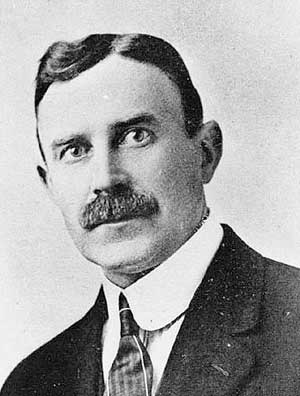Hegg (Eric A.) Photographs of Alaska and the Klondike, 1897-1901
Sample Searches
- Nome
- Mining
- Transportation Methods
- Women of the Klondike
- Yukon River
- Dawson City
- Chilkoot Pass
- White Pass
- Disasters
More Hegg Photographs
American Indians of the Pacific Northwest
Other Resources
Klondike Gold Rush: The Perilous Journey North
The Evergreen State..in Black and White
Northwest of the West: The Frontier Experience on the Northwest Coast
Photographs documenting the Klondike and Alaska gold rushes from 1897 - 1901. Images include depictions of frontier life in Dawson City, the Yukon Territory, and Skagway and Nome, Alaska.
Eric A. Hegg who was born in Sweden, arrived in the Puget Sound region in 1888. Settling in Whatcom County, he opened photographic studios both in New Whatcom and Fairhaven. Both businesses were probably managed in part by his brother Peter L. Hegg.
In the fall of 1897, after hearing of the gold strikes in the Yukon Territories, he joined the thousands of gold seekers heading north. Accompanied by a group of men from Bellingham Bay, he traveled by steamboat up the Inside Passage through British Columbia to his destination in Alaska. Finding his passage further north closed due to the freezeup on the Yukon River, he settled temporarily in Dyea, Alaska which was the jumping off point for the Chilkoot Trail to Dawson. Here he opened a small photography studio. Later, during the winter of 1897-1898, he established a second, more substantial, studio in Skagway. The photographer Per Edward (Ed) Larss who had arrived in Skagway in March of 1898, was employed by Hegg to assist in documenting the huge migration to the Yukon known as "the Stampede". For a short time, he and Larss made frequent trips to the Chilkoot Pass following the footsteps of the thousands of Klondikers who wound their way up the Dyea River to the Golden Staircase and over over into British Columbia. They also documented scenes along the White Pass Trail. Along the trails they recorded the sail driven sleds, temporary tent towns, piles of snow covered food caches and the many hardships endured by the Klondikers as they neared their goal.
During the Summer of 1898, Hegg travelled northward on the Yukon River toward Dawson with his brother, Peter Hegg, friend P.B. Anderson, and partner P.E. Larss. Before Hegg left in June, he turned the majority of his work which was produced in the British Columbia town of Bennett over to the photographer Edward Hamacher who later relocated to Whitehorse. Many of the photographs he took on this journey were taken and developed under arduous circumstances. His traveling darkroom was in the bow of the small boat built for the trip.
After arriving in Dawson , Yukon Territory, he set up a formal partnership with P. E. Larss in a shop near the waterfront between First and Second Streets. He continued, however, to maintain studios in both the Yukon Territory and in Skagway , Alaska , traveling, on occasion, between the two to check on operations. Tragedy struck in October 1898 when the Dawson studio was devastated by a fire. The studio was rebuilt and in November of 1898 George G. Cantwell joined the staff in Dawson to assist with outside photographic work.
Returning to Skagway in the winter of 1899 he took the opportunity to photograph the Atlin Gold Rush and the building of the White Pass and Yukon Railroad. In the meantime, Larss remained in the Dawson and continued the business under the name of Hegg & Co. and Hegg and Larss. All of the photographs produced under this label were made by Larss during the time that Hegg was absent for Dawson . During the July of 1899, Hegg sold his interest in his Dawson studio to Larss who subsequently entered into partnership with Joseph Duclos and headed for Nome to record the reports of new gold strikes. He spent two years recording life on the Seward Peninsula , which included mining operations in Nome and the surrounding area.
In 1902 in a bitter divorce from his wife Ella, who operated the Skagway studio, many of Hegg's negatives and photographs were sold to a Seattle , Washington firm of Webster and Stevens, who removed the Hegg studio imprint from the negatives and sold prints made from Hegg's negatives as products of their studio. The remaining assets of the Skagway studio were absorbed by Dedman's Photo Shop, which continues in business to this day in the town of Skagway.
Hegg eventually left Alaska after having moved back and forth between Seattle, Juneau and Cordova. Although difficult to track his movements during this time period, he did sign on as company photographer for the Copper River and Northwestern Railroad, documenting it's construction and views of Cordova until 1918.
Later he accepted an assignment for a San Francisco newspaper in Hawaii. He returned to Bellingham to set up another photography studio and died in San Diego in 1947.
In September, Hegg left for Skagway to check on his other studio and then continued on to New York City where he was exhibiting photographs of the Gold Rush.
About the Database
Selection, research and descriptive metadata for the Eric A. Hegg Photographs were completed by Kristin Kinsey in 1999. Not all the photographs from the collection were included in this database: The database consists of 730 digital images chosen from a group of over 2100 photographic prints. The photographs were scanned in grayscale using a Microtek Scanmaker 9600L and saved in .jpg format. Some manipulation of the images was done to present the clearest possible digital image. The scanned images were then linked with descriptive data using the UW CONTENT program. The original collection resides in the UW Libraries Special Collections Division as the Eric A. Hegg Collection. PH Coll 274.


